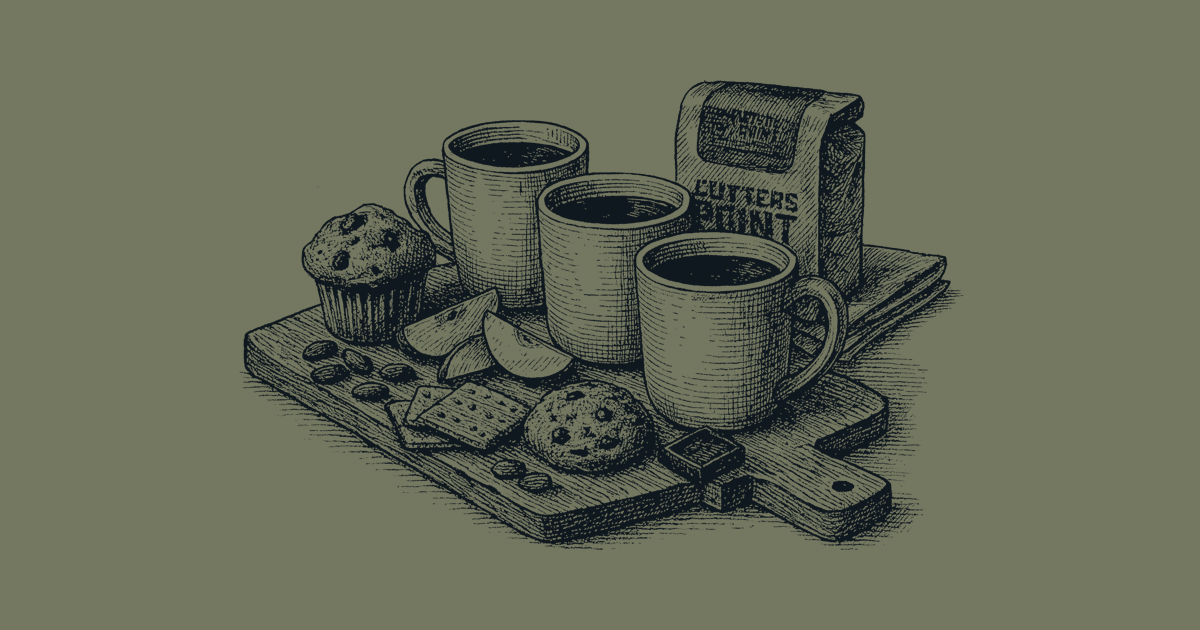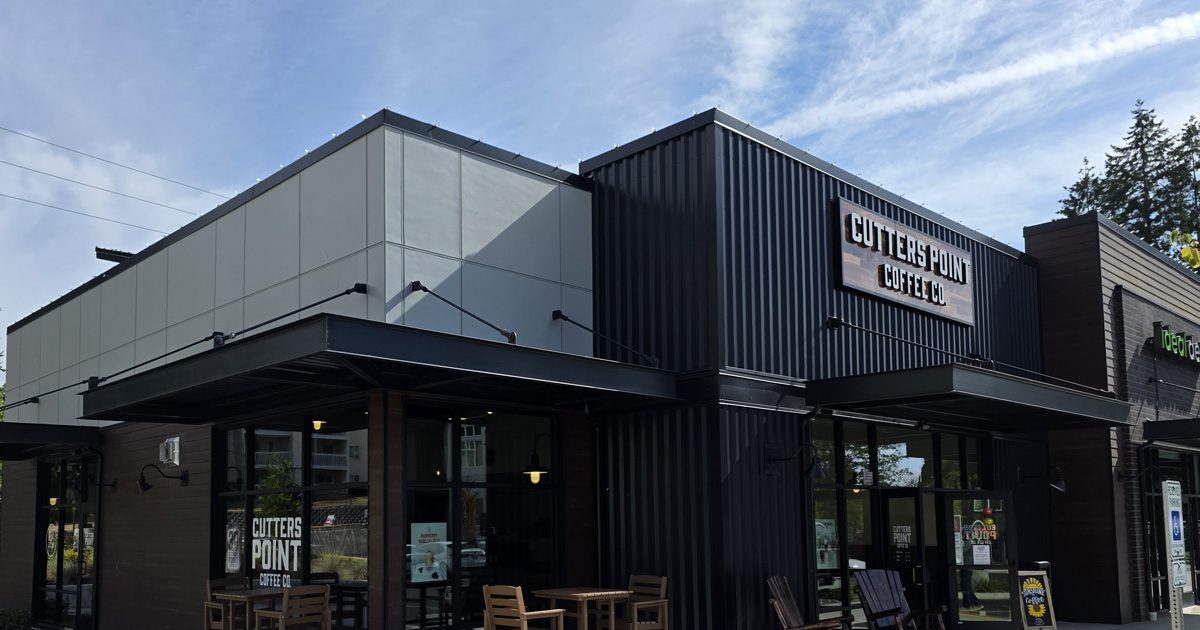Brew It Right: Home Coffee Brewing Methods & Grind Guide | Cutters Point Coffee
Brew It Right: The Ultimate Home Coffee Guide by Method & Grind
You’ve fixed your brewing mistakes. You’re grinding your own beans. You’ve got your favorite brew method. But something still feels… off.
The truth? Even solid coffee habits can fall short if your grind size doesn’t match your brewing style. Whether your cup tastes too sour, too bitter, or just a little empty, the fix might be simpler than you think.
In this guide, we’re breaking down the most popular home coffee brewing methods, and exactly how to pair each one with the right grind, tools, and timing. From pour over precision to cold brew smoothness, you’ll learn how to brew it right every time.
Let’s dial in.
Why Method + Grind Matter More Than You Think. Ready?
Most home brewers focus on the gear: the kettle, the dripper, the machine. But if your grind size doesn’t match your brewing method, you’re setting yourself up for a disappointing cup, no matter how great your coffee or tools are.
Each brewing method extracts flavor differently. Some need a slow, even saturation (like French press), while others require a fast, precise flow (like espresso). The grind controls how water moves through the coffee, and how much flavor is pulled from the beans. If it’s too fine, you’ll over-extract and get bitterness. Too coarse? You’ll under-extract, leaving your cup weak and sour.
The good news? Once you understand how grind size, brew time, and method work together, your coffee goes from flat and forgettable to full-bodied and brag-worthy.
Brew Methods Breakdown (Simplified)

French Press
Grind: Coarse (think sea salt)
Brew Time: 4:00 minutes
Best For: Full-bodied, low-acid coffee with heavy texture
Recommended Gear: French press, burr grinder, scale, kettle
French press is as straightforward as coffee brewing gets. But it also demands the right grind. Use coffee that’s too fine, and you’ll end up with a silty, over-extracted mess. Too coarse, and you’ll wonder if you even brewed anything at all.
Stick with a coarse grind that allows the coffee to steep evenly without clogging your filter. After four minutes, press the plunger slowly and pour immediately to avoid over-extraction. It’s bold, it’s rich, and it’s forgiving, as long as your grind is right.
Pro Tip:
Don’t let it sit after plunging. The longer coffee stays in contact with the grounds, the more bitter it becomes.

Pour Over (Hario, Chemex, Kalita, etc.)
Grind: Medium-fine (like beach sand)
Brew Time: 2:30 to 4:00
Best For: Bright, clean, and nuanced cups
Recommended Gear: Pour over dripper, gooseneck kettle, burr grinder, scale, filters
Pour over brewing is all about control. You’re guiding the water, managing the flow rate, and unlocking delicate flavors that get lost in immersion methods. But the secret to clarity in the cup? It starts with the right grind.
Too coarse, and the water runs through too fast, under-extracting your coffee. Too fine, and you’ll clog the filter and drag out the brew time, leaving you with a muddy, over-extracted result.
Aim for a grind that’s somewhere between table salt and sand. It should resist the water just enough to allow full saturation without choking the flow.
Pro Tip:
Start with a 30-second bloom using twice the weight of your coffee in water, then pour slowly in concentric circles. Let the grounds settle and finish the pour within 2 minutes and a total brew time of no more than 4 minutes for best results.

AeroPress
Grind: Medium-fine (just slightly finer than drip)
Brew Time: 1:00 to 2:00 minutes
Best For: Clean, punchy, espresso-adjacent brews with lots of flexibility
Recommended Gear: AeroPress, burr grinder, scale, stirrer, kettle
AeroPress is the wild card of home brewing. You can brew it fast and clean like a pour over, or flip it upside down and steep it like a French press. But no matter your method, grind size still makes or breaks your cup.
A medium-fine grind gives you just the right resistance for a balanced, rich extraction without clogging the filter or forcing a 10-second plunge. If your brew tastes sour or weak, grind finer. If it’s overly bitter or takes too much effort to press, go coarser.
Pro Tip:
Want a richer, crema-like shot from your AeroPress? Try the inverted method and pair it with the Fellow Prismo attachment. It adds pressure and control, giving you a more espresso-style brew without the machine. Bloom for 30 seconds, stir, steep for another 45, then plunge slowly. It’s quick, satisfying, and surprisingly smooth.

Espresso
Grind: Fine (like powdered sugar, but not clumpy)
Brew Time: 25 to 30 seconds (for a standard double shot)
Best For: Rich, concentrated flavor with crema and intensity
Recommended Gear: Espresso machine, burr grinder (with micro-adjustments), tamper, scale
Espresso is precision-driven and unforgiving. Every variable, grind size, tamp pressure, dose, and water temp, affects the shot. But it all starts with grind. If it’s too coarse, the water rushes through and your espresso will be thin and sour. Too fine, and it chokes the machine, over-extracting the coffee and turning it bitter.
A proper espresso grind should feel like soft flour between your fingers, but without clumping. You’ll need a burr grinder that allows fine adjustments to really dial it in, especially as beans age or humidity shifts.
Pro Tip:
Watch the clock. A double shot should take about 25 to 30 seconds to pull. If it runs too long, make the grind coarser. If it finishes too fast, tighten it up with a finer grind. Start with 18 grams in and aim for 36 grams out, then adjust as needed to hit that sweet spot.

Cold Brew
Grind: Extra coarse (like raw sugar or cracked peppercorns)
Brew Time: 12 to 18 hours
Best For: Smooth, low-acid coffee served over ice or as concentrate
Recommended Gear: Cold brew maker, large mason jar or pitcher, burr grinder, paper or metal filter
Cold brew is the easiest way to make a big batch of coffee that stays fresh for days, but the grind size is key to making it taste clean and balanced. If the grind is too fine, you’ll end up with cloudy, over-extracted coffee that has a chalky or bitter finish. Too coarse, and your cold brew might come out watery and weak.
Aim for a grind that’s even coarser than French press. The larger particles steep slowly, releasing flavor gently without pulling excess bitterness. You can brew it in the fridge or on the counter, but make sure to strain it well to avoid any grit in the final cup.
Pro Tip:
Start with a 1:8 coffee-to-water ratio for ready-to-drink cold brew, or go stronger at 1:4 if you want a concentrate you can dilute later. Once it's brewed, strain through a fine mesh sieve lined with a paper filter or a reusable cloth filter to remove grit and sediment. Store in the fridge and use within a week for best flavor.

Auto Drip
Grind: Medium (similar to regular sand)
Brew Time: Depends on machine size and model
Best For: Convenience, consistency, and batch brewing
Recommended Gear: Auto drip coffee maker, burr grinder, filters, scale
Auto drip machines are everywhere, from home kitchens to office break rooms, but they’re often misunderstood. Just because a machine does the work doesn’t mean it’s brewing great coffee. The grind size, ratio, and even how you load the filter can make a big difference in the final cup.
Stick with a medium grind. Too fine, and the water won’t flow through evenly, leading to bitter, over-extracted coffee. Too coarse, and the water will rush through before the grounds have time to steep properly, leaving you with a weak or sour result.
Pro Tip:
Not all auto drip brewers are created equal. Many budget-friendly machines don’t heat water to the ideal range (195°F to 205°F), which means your coffee never brews at full flavor. Instead, they rely on the hot plate to warm the coffee after it's already brewed, often degrading the taste. If upgrading isn’t an option yet, consider brewing smaller batches and drinking them fresh off the pot.
Also, remember that most machines measure in 5-ounce “cups,” not standard 8-ounce ones. Use a digital scale for accuracy and start with a 1:16 coffee-to-water ratio. Not ready to measure? Here's a quick reference:

What Grinder Should You Use? (And Why Burr Matters)
If there’s one upgrade that instantly improves your coffee, it’s switching from a blade grinder to a burr grinder. Blade grinders chop beans unevenly, which leads to inconsistent extraction. Some grounds are too fine and over-extract, others are too coarse and under-extract.
A burr grinder crushes the beans between two burrs, producing a uniform particle size that gives you more control over taste and brew time. You’ll get a cleaner, more balanced cup across every brew method.
Why We Recommend the Fellow Opus

The Fellow Opus Conical Burr Grinder is compact, powerful, and designed for versatility. It’s not just for espresso—it’s made to cover the full range of brewing styles with 41+ precision settings.
Key features:
- 6-blade 40mm conical burrs for high grind quality
- Full-range adjustment from espresso-fine to cold brew-coarse
- Anti-static technology for cleaner dosing
- Single-dose loading or hopper-style use
- Magnetic catch cup and a small footprint that fits any counter
Whether you’re pulling espresso or brewing French press, the Opus makes it easy to dial in your grind and repeat great results.
Pro Tip:
Start with the grind setting recommended for your brew method, but let taste be your guide. If your coffee tastes bitter, try a coarser grind. If it’s sour or weak, tighten it up a bit. Keep notes as you go, your grinder is a tool, not a guess. Also check out this amazing Brewler and Grind Size Reference Chart bur Kruve here.
Ready to Brew It Right? Start Here.
Now that you’ve got the method, grind, and gear mapped out, all that’s left is to start brewing. Whether you’re perfecting your pour over or finally dialing in that espresso shot, a better cup is just one adjustment away.
At Cutters Point, we’re all about helping you enjoy coffee that tastes as good at home as it does in our cafés. That starts with fresh, well-sourced beans, the right gear, and a little bit of know-how—like the guide you just read.
👉 Explore our brewing gear and whole bean coffees to match your favorite method
👉 View our printable grind & brew cheat sheet below to keep by your setup
👉 Got questions? View our Coffee Guide videos or drop us a line anytime
Your best cup of coffee is closer than you think. Let’s brew it right.

keep reading
Get our latest brewing guide videos


and the stories behind the coffee
in your inbox


Get our latest brewing guide videos and the stories behind the coffee in your inbox


















